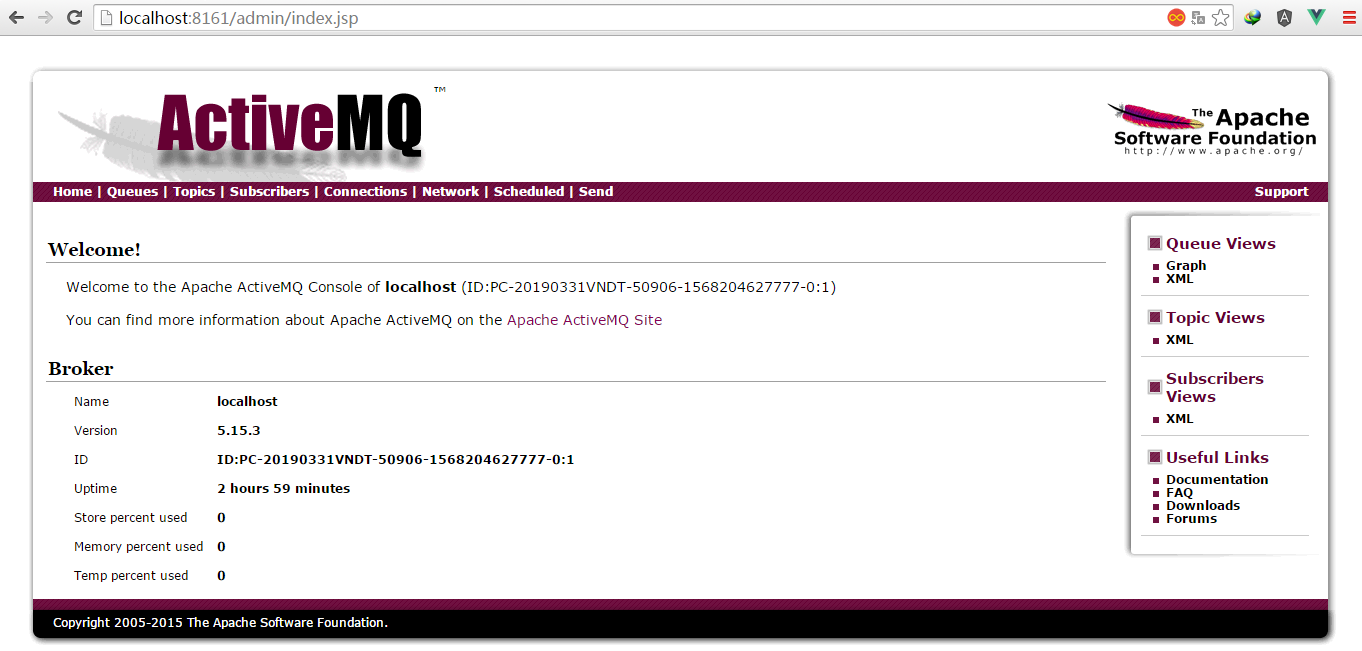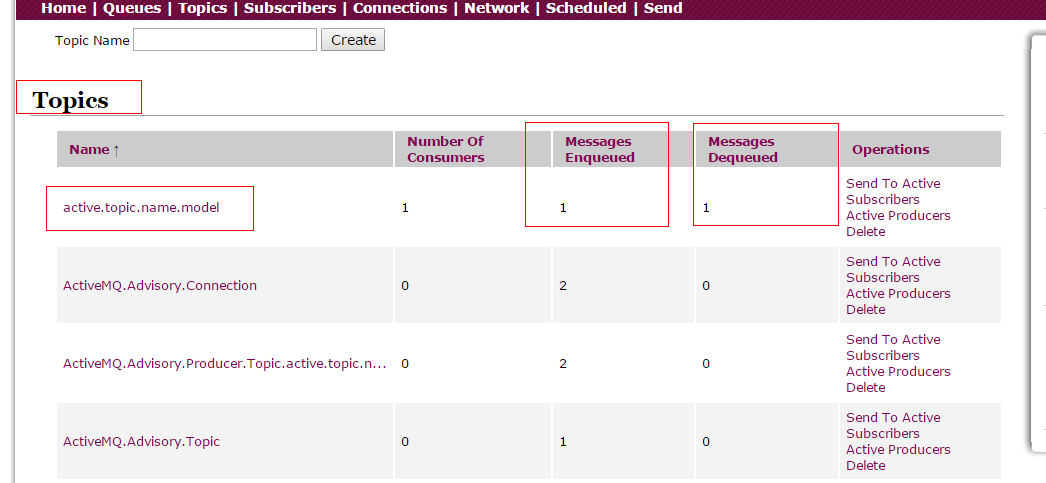一、ActiveMQ简介
1). ActiveMQ
ActiveMQ是Apache所提供的一个开源的消息系统,完全采用Java来实现,因此,它能很好地支持J2EE提出的JMS(Java Message Service,即Java消息服务)规范。JMS是一组Java应用程序接口,它提供消息的创建、发送、读取等一系列服务。JMS提供了一组公共应用程序接口和响应的语法,类似于Java数据库的统一访问接口JDBC,它是一种与厂商无关的API,使得Java程序能够与不同厂商的消息组件很好地进行通信。
2). Java Message Service(JMS)
JMS支持两种消息发送和接收模型。
-
一种称为P2P(Ponit to Point)模型,即采用点对点的方式发送消息。P2P模型是基于队列的,消息生产者发送消息到队列,消息消费者从队列中接收消息,队列的存在使得消息的异步传输称为可能,P2P模型在点对点的情况下进行消息传递时采用。
 图1.png
图1.png -
另一种称为Pub/Sub(Publish/Subscribe,即发布-订阅)模型,发布-订阅模型定义了如何向一个内容节点发布和订阅消息,这个内容节点称为topic(主题)。主题可以认为是消息传递的中介,消息发布这将消息发布到某个主题,而消息订阅者则从主题订阅消息。主题使得消息的订阅者与消息的发布者互相保持独立,不需要进行接触即可保证消息的传递,发布-订阅模型在消息的一对多广播时采用。
 图2.png
图2.png
3). JMS术语
- Provider/MessageProvider:生产者
- Consumer/MessageConsumer:消费者
- PTP:Point To Point,点对点通信消息模型
- Pub/Sub:Publish/Subscribe,发布订阅消息模型
- Queue:队列,目标类型之一,和PTP结合
- Topic:主题,目标类型之一,和Pub/Sub结合
- ConnectionFactory:连接工厂,JMS用它创建连接
- Connnection:JMS Client到JMS Provider的连接
- Destination:消息目的地,由Session创建
- Session:会话,由Connection创建,实质上就是发送、接受消息的一个线程,因此生产者、消费者都是Session创建的
二、Windows安装 ActiveMq
1、下载地址:http://activemq.apache.org/download-archives.html ,本文用的是windows版的5.15.3版本,下载下来是压缩包。apache-activemq-5.15.3-bin.zip
2、将压缩包解压一个到目录下,CMD进入到解压目录下的bin目录下,执行 activemq.bat start 启动。 如果能成功访问 http://localhost:8161/admin(用户名和密码默认为admin),则启动成功。

三、SpringBoot 集成 ActiveMQ
1. 创建一个springboot项目,添加依赖
<!--ActiveMq-->
<dependency>
<groupId>org.springframework.boot</groupId>
<artifactId>spring-boot-starter-activemq</artifactId>
<version>1.5.0.RELEASE</version>
</dependency>
<!--消息队列连接池-->
<dependency>
<groupId>org.apache.activemq</groupId>
<artifactId>activemq-pool</artifactId>
<version>5.15.0</version>
</dependency>
2、application.yml文件的配置
server: port: 8080 spring: activemq: broker-url: tcp://127.0.0.1:61616 user: admin password: admin close-timeout: 15s # 在考虑结束之前等待的时间 in-memory: true # 默认代理URL是否应该在内存中。如果指定了显式代理,则忽略此值。 non-blocking-redelivery: false # 是否在回滚回滚消息之前停止消息传递。这意味着当启用此命令时,消息顺序不会被保留。 send-timeout: 0 # 等待消息发送响应的时间。设置为0等待永远。 queue-name: active.queue topic-name: active.topic.name.model # packages: # trust-all: true #不配置此项,会报错 pool: enabled: true max-connections: 10 #连接池最大连接数 idle-timeout: 30000 #空闲的连接过期时间,默认为30秒 # jms: # pub-sub-domain: true #默认情况下activemq提供的是queue模式,若要使用topic模式需要配置下面配置 # 是否信任所有包 #spring.activemq.packages.trust-all= # 要信任的特定包的逗号分隔列表(当不信任所有包时) #spring.activemq.packages.trusted= # 当连接请求和池满时是否阻塞。设置false会抛“JMSException异常”。 #spring.activemq.pool.block-if-full=true # 如果池仍然满,则在抛出异常前阻塞时间。 #spring.activemq.pool.block-if-full-timeout=-1ms # 是否在启动时创建连接。可以在启动时用于加热池。 #spring.activemq.pool.create-connection-on-startup=true # 是否用Pooledconnectionfactory代替普通的ConnectionFactory。 #spring.activemq.pool.enabled=false # 连接过期超时。 #spring.activemq.pool.expiry-timeout=0ms # 连接空闲超时 #spring.activemq.pool.idle-timeout=30s # 连接池最大连接数 #spring.activemq.pool.max-connections=1 # 每个连接的有效会话的最大数目。 #spring.activemq.pool.maximum-active-session-per-connection=500 # 当有"JMSException"时尝试重新连接 #spring.activemq.pool.reconnect-on-exception=true # 在空闲连接清除线程之间运行的时间。当为负数时,没有空闲连接驱逐线程运行。 #spring.activemq.pool.time-between-expiration-check=-1ms # 是否只使用一个MessageProducer #spring.activemq.pool.use-anonymous-producers=true
3、启动类增加 @EnableJms 注解
import org.springframework.boot.SpringApplication;
import org.springframework.boot.autoconfigure.SpringBootApplication;
import org.springframework.jms.annotation.EnableJms;
@SpringBootApplication
@EnableJms //启动消息队列
public class SpringbootActivemqApplication {
public static void main(String[] args) {
SpringApplication.run(SpringbootActivemqApplication.class, args);
}
}
4、初始化和配置 ActiveMQ 的连接
import org.apache.activemq.ActiveMQConnectionFactory; import org.apache.activemq.command.ActiveMQQueue; import org.apache.activemq.command.ActiveMQTopic; import org.springframework.beans.factory.annotation.Value; import org.springframework.context.annotation.Bean; import org.springframework.context.annotation.Configuration; import org.springframework.jms.config.JmsListenerContainerFactory; import org.springframework.jms.config.SimpleJmsListenerContainerFactory; import org.springframework.jms.core.JmsMessagingTemplate; import javax.jms.ConnectionFactory; import javax.jms.Queue; import javax.jms.Topic; @Configuration publicclass BeanConfig { @Value("${spring.activemq.broker-url}") private String brokerUrl; @Value("${spring.activemq.user}") private String username; @Value("${spring.activemq.topic-name}") private String password; @Value("${spring.activemq.queue-name}") private String queueName; @Value("${spring.activemq.topic-name}") private String topicName; @Bean(name = "queue") public Queue queue() { return new ActiveMQQueue(queueName); } @Bean(name = "topic") public Topic topic() { return new ActiveMQTopic(topicName); } @Bean public ConnectionFactory connectionFactory(){ return new ActiveMQConnectionFactory(username, password, brokerUrl);
} @Bean public JmsMessagingTemplate jmsMessageTemplate(){ return new JmsMessagingTemplate(connectionFactory()); } // 在Queue模式中,对消息的监听需要对containerFactory进行配置 @Bean("queueListener") public JmsListenerContainerFactory<?> queueJmsListenerContainerFactory(ConnectionFactory connectionFactory){ SimpleJmsListenerContainerFactory factory = new SimpleJmsListenerContainerFactory(); factory.setConnectionFactory(connectionFactory); factory.setPubSubDomain(false); return factory; } //在Topic模式中,对消息的监听需要对containerFactory进行配置 @Bean("topicListener") public JmsListenerContainerFactory<?> topicJmsListenerContainerFactory(ConnectionFactory connectionFactory){ SimpleJmsListenerContainerFactory factory = new SimpleJmsListenerContainerFactory(); factory.setConnectionFactory(connectionFactory); factory.setPubSubDomain(true); return factory; } }
5、生产者(queue 和 topic)
import org.springframework.beans.factory.annotation.Autowired; import org.springframework.jms.core.JmsMessagingTemplate; import org.springframework.web.bind.annotation.PostMapping; import org.springframework.web.bind.annotation.RequestBody; import org.springframework.web.bind.annotation.RestController; import javax.jms.Destination; import javax.jms.Queue; import javax.jms.Topic; @RestController public class ProducerController { @Autowired private JmsMessagingTemplate jmsMessagingTemplate; @Autowired private Queue queue; @Autowired private Topic topic; @PostMapping("/queue/test") public String sendQueue(@RequestBody String str) { this.sendMessage(this.queue, str); return "success"; } @PostMapping("/topic/test") public String sendTopic(@RequestBody String str) { this.sendMessage(this.topic, str); return "success"; } // 发送消息,destination是发送到的队列,message是待发送的消息 private void sendMessage(Destination destination, final String message){ jmsMessagingTemplate.convertAndSend(destination, message); } }
6、Queue模式的消费者
import org.springframework.jms.annotation.JmsListener;
import org.springframework.stereotype.Component;
@Component
public class QueueConsumerListener
{
//queue模式的消费者
@JmsListener(destination="${spring.activemq.queue-name}", containerFactory="queueListener")
public void readActiveQueue(String message) {
System.out.println("queue接受到:" + message);
}
}
7、topic模式的消费者
import org.springframework.jms.annotation.JmsListener; import org.springframework.stereotype.Component; @Component public class TopicConsumerListener { //topic模式的消费者 @JmsListener(destination="${spring.activemq.topic-name}", containerFactory="topicListener") public void readActiveQueue(String message) { System.out.println("topic接受到:" + message); } }
8、测试(使用Postman发消息)
(1) POST: http://localhost:8080/queue/test 消息体:{"aaa" : "queue"}
控制台打印:queue接受到:{"aaa" : "queue"}
(2) POST: http://localhost:8080/topic/test 消息体:{"aaa" : "topic"}
控制台打印:topic接受到:{"aaa" : "topic"}

topic模式有普通订阅和持久化订阅
普通订阅:在消费者启动之前发送过来的消息,消费者启动之后不会去消费;
持久化订阅: 在消费者启动之前发送过来的消息,消费者启动之后会去消费;